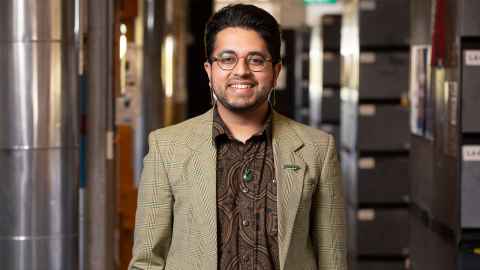Aucklanders invited to map their emotional ties to the city
8 October 2024
A new art installation by architecture and planning student Sahil Tiku asks Aucklanders to weave their memories of living in the city into a communal tapestry.

A new interactive art installation is inviting Aucklanders to reflect on their emotional ties to the city they call home.
Tapestries of Tāmaki encourages participants to explore memories and emotions connected to Auckland’s diverse landscape, from its volcanic maunga to its urban spaces. The aim is to deepen the connection between Aucklanders and the whenua beneath their feet, while celebrating the city’s rich blend of cultures and histories.
Designed by Sahil Tiku, a masters student at the University of Auckland’s Te Pare School of Architecture and Planning, the installation is one of nine artistic projects from staff and students on display at this year’s Urban Art Village, a free event held in Auckland on Thursday 10 October as part of ArtWeek 2024.
Tapestries of Tāmaki invites participants to place a flag on a topographic map of Auckland’s Isthmus, signifying a location of personal importance tied to an emotion or memory.
After marking their chosen spot, participants use a loom to weave a ribbon into a communal tapestry, contributing to a living artwork that embodies the diverse emotional connections Aucklanders have with their city.
Tiku says the installation offers people a moment to pause and reflect on their memories.
“Every city is, for every individual, a patchwork of feelings. There’s the bench where someone had a first kiss, the building where they got their first promotion, or a restaurant that played host to a breakup. We rarely stop to consider this notion in our day-to-day lives,” he says.

Tiku’s masters thesis explores how non-traditional architectural methods can foster connections between people and place. His work draws on a provocation by the late Rewi Thompson, a prominent architect and educator, who emphasised that architecture in Aotearoa has a responsibility to mediate the relationship between people and land.
“In Aotearoa, our lives are underpinned by Te Tiriti o Waitangi, and we are fortunate to share this land with a people who have a deep connection to it. The cultures of Aotearoa are diverse, making their home on whenua Māori, yet they each maintain distinct relationships with the land. I believe that’s where Tapestries of Tāmaki finds its niche: in a way that is hopefully not too prescriptive or appropriative, it encourages people to reflect on how they have lived on this land,” says Tiku.
By using mapping and weaving, the installation is an opportunity for “everyone to play architect”, says Tiku.
“The idea is there are these ‘architectural’ tools that everyone can relate with or ascribe meaning to, and they become ways of recording relationships with the land, creating a record of tacit knowledge.”
Ultimately, he wants Tapestries of Tāmaki to leave a lasting impression on those who participate.
“I hope Tapestries of Tāmaki helps people realise just how exquisite their city is. If people walk away with a smile on their face, with the realisation that they live in a very special place in the world, I will walk away happy.”
Urban Art Village takes place on O’Connell Street on Thursday 10 October, from 12pm until 9pm. It is part of ArtWeek, run every year by Heart of the City. Learn more about the installations by Te Pare School of Architecture and Planning students.
Media contact
Hussein Moses | Media adviser
M: 027 361 1000
E: hussein.moses@auckland.ac.nz